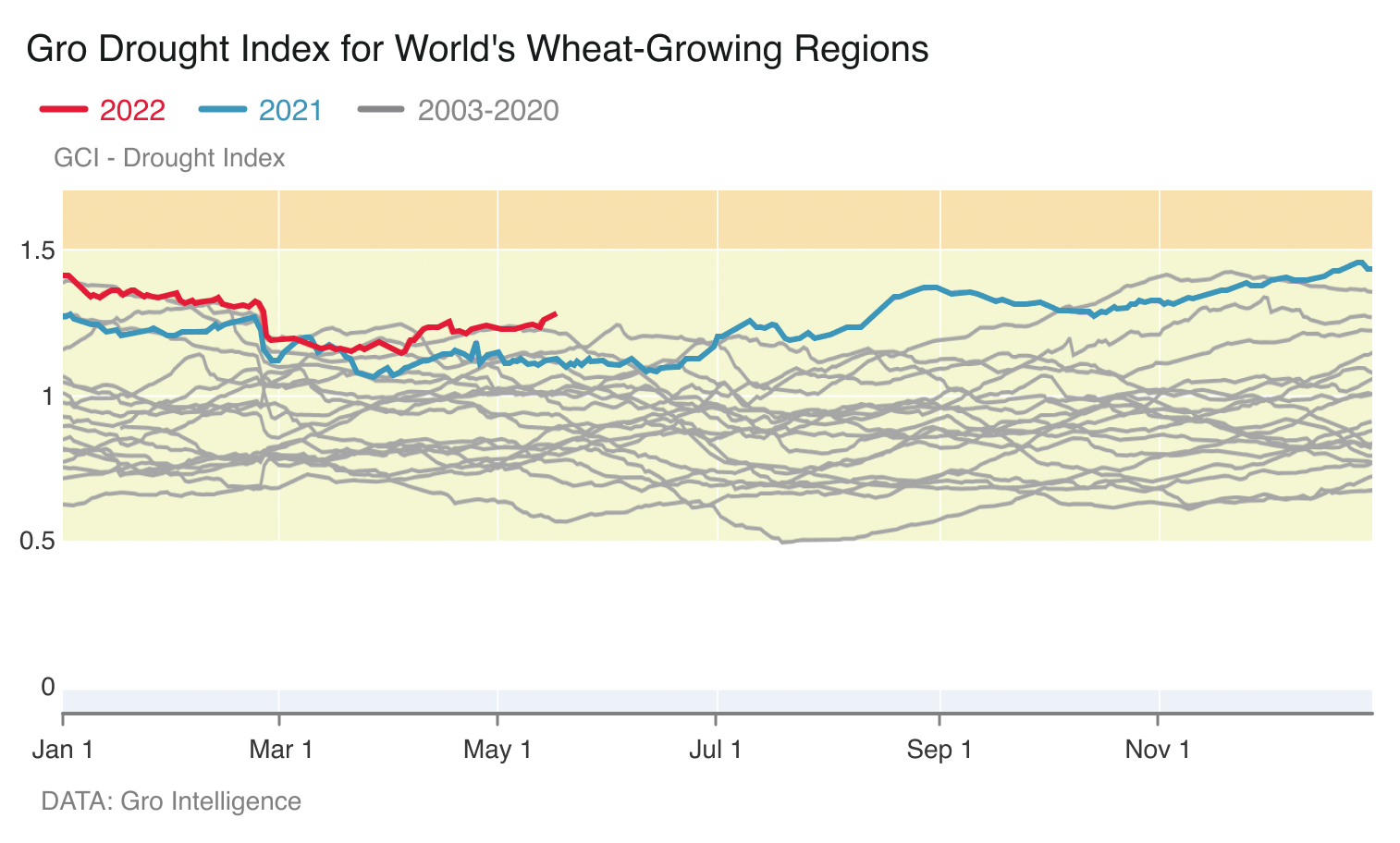An aggregation of growing conditions in all the world’s wheat-growing regions shows soil moisture levels are at their lowest point since at least 2010, according to Gro’s Climate Risk Navigator for Agriculture. Meanwhile, the Gro Drought Index, weighted for the world’s wheat acres in the Climate Risk Navigator, is showing the highest readings since at least 2003.

Worldwide production of wheat, the most important crop affecting food security, is forecast to decline this year for the first time in four years. The global wheat stocks-to-use ratio, a key measure of available supplies, is projected to drop in 2022/23 to the lowest level in seven years, marking the third consecutive annual decline in wheat inventories.
Tight global wheat supplies have pushed benchmark futures prices on the CME up by 57% so far this year.
Russia’s invasion of Ukraine in February exacerbated the world’s supply squeeze by halting shipments of wheat from the Black Sea region. Also compounding the problem are wheat export restrictions enacted by some governments, including Russia and India, to control rising domestic prices.
 Russia-Ukraine crisis highlights Africa’s need to diversify its wheat sources
Russia-Ukraine crisis highlights Africa’s need to diversify its wheat sources
France presents one of the most worrisome pictures, as scant rainfall and high temperatures depress growing conditions in Europe’s top wheat supplier. With Ukraine wheat sidelined by its war with Russia, drought hit countries across the Middle East and North Africa have been counting on France to help fill the supply gap.
France’s durum and soft wheat crops, which are harvested in July and August, are currently in the key growing months that have the greatest bearing on final crop yield. But soil moisture readings for the country’s wheat regions are at their lowest levels in at least 12 years, Gro’s Climate Risk Navigator shows.
US wheat prospects are also at risk, as the winter wheat and spring wheat crops continue to face adverse conditions. Gro’s machine-learning US Hard Red Winter Wheat (HRW) Yield Forecast Model is pointing to a double-digit yield decline, as hot and dry conditions blanket the HRW growing areas in the southern Plains. Meanwhile, the US hard red spring wheat (HRS) crop to the north is struggling with spring planting because excessive rains are hampering sowing. North Dakota, the top HRS-producing state, is currently experiencing the slowest planting season since 2011.

Elsewhere, Iran, the Middle East’s top wheat producer, is expected to see production drop 20% this year to 12 million tonnes, which is 17% below the 5-year average. Iran’s wheat-growing areas have experienced “severe” levels of drought since mid-2021, according to Gro’s Drought Index, weighted for wheat acres in Iran using the Gro Climate Risk Navigator.
Wheat production in Morocco is projected to be down 35% this year to 3.22 million tonnes, Gro’s model shows. Morocco, one of the top wheat producing countries in Africa as well as a large wheat importer, has experienced one of the worst droughts in nearly two decades since late last year, as shown by the Gro Drought Index weighted for the country’s wheat areas.
Gro’s Climate Risk Navigator for Agriculture enables users to evaluate and compare growing conditions anywhere in the world, in real time and on a historical basis. The application’s ability to weight growing conditions for a specific crop is a valuable function when crops are spread widely within a country and when yield forecast models aren’t available.














